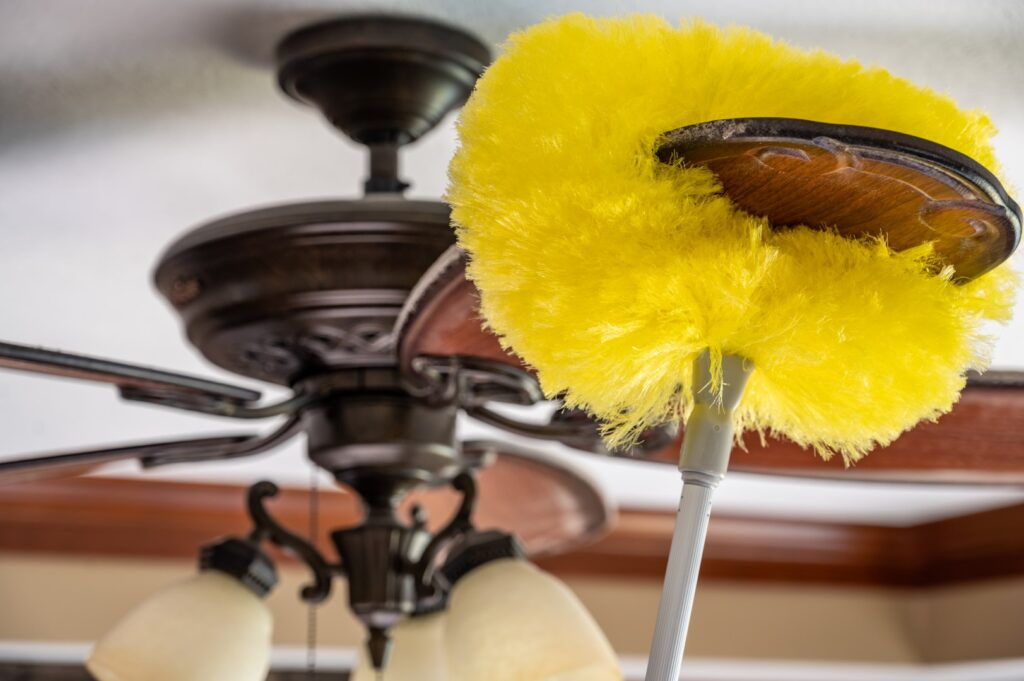Overhead fans are a staple fixture in most homes and a great way to keep your home’s temperature regulated. Of course, a clean and well-maintained ceiling fan works wonders for performance, air quality, and even the unit’s lifespan.
Dust and dirt build-up can lead to performance issues if not cleaned and maintained regularly. Keep reading for the answers to some of your most frequently asked questions about keeping your ceiling fans clean and well-maintained.
- What are the benefits of cleaning my ceiling fan?
- How often should I clean my ceiling fan?
- How do I clean a ceiling fan?
- Do ceiling fans need maintenance?
Did you know home warranties can cover ceiling fans? This includes all parts and components that keep the fan working. Learn more about coverage and get a free quote today!
What are the benefits of cleaning my ceiling fan?
Keeping your ceiling fans clean and well-maintained has both aesthetic and fiscal benefits.
- Your home will look and feel better.
- Cooling your home will be more efficient and air will circulate more effectively.
- It reduces the amount of dust and dirt in the air you breathe.
Even the best fans have an expiration date, so the best way to make the most out of their lifespan is to keep it properly cleaned and maintained.
Save more money! Check out these recommended thermostat settings for every season.
How often should I clean my ceiling fan?
The frequency in which you should clean your ceiling fan depends on how dusty your home is.
- If you live in a dusty area, you may need to clean your fan once a month.
- If you live in a less dusty area, you may only need to clean your fan once every few months.
Fortunately, cleaning a ceiling fan is something you can easily do yourself regardless of where you live.
How do I clean a ceiling fan? (6 Steps)
Investing a small amount of time towards cleaning and maintenance helps avoid long-term damage and surprise expenses.
You’ll need:
- Step Stool or Ladder
- Screwdriver
- Soft Cloth
- Warm Water
- Mild Detergent
- Extendable Duster
Learn how to clean your ceiling fan by following the six steps below.
1. Turn off your ceiling fan.
The first thing you need to do is turn off the fan. This is important for safety, as well as to prevent the fan blades from spinning while you’re cleaning them.
2. Remove the blades and light covers.
In most cases, ceiling fan blades are removable. If they are, take them off so that you can clean them more easily. Use a step stool or ladder to reach the fan safely.
You’ll typically need a screwdriver to remove the blades and light covers.
3. Dust the blades and light covers.
Use a soft cloth to dust the blades of your ceiling fan, as well as the glass light covers. Be sure to get into all the crevices.
4. Clean the fan motor housing.
Use a damp cloth to clean the fan housing. Be sure to wipe away any dust or dirt that has accumulated. If it’s not too dirty, you can also use an extendable duster to gently wipe it clean.
5. Wash the blades.
If the blades of your ceiling fan are particularly dirty, you can wash them with warm, soapy water. Be sure to rinse them thoroughly and dry them completely before putting them back on the fan.
6. Reinstall the blades.
Once the blades are clean and dry, you can reinstall them on the fan. Be sure to line them up correctly so that they are evenly spaced.
Once the blades are reinstalled you are now ready to turn your fan on and enjoy a clean, fresh breeze.
Does your fan make any odd noises or appear wobbly? Read on for some simple maintenance tasks that can save you money in the long run!
Do ceiling fans need maintenance?
Yes! Just like any electrical fixture or appliance, you want to make sure to perform regular maintenance in order to ensure you make the most out of the product’s lifespan.
How do you maintain a ceiling fan?
Below is a list of maintenance tasks we recommend for your ceiling fan.
- Clean out the fan. As mentioned, cleaning your fan on a regular basis is the first step to properly maintaining your fixture.
- Tighten all screws. A noisy fan is usually caused by loose screws. You can use a screwdriver to tighten these screws. This should stop it from shaking and prevent further damage to the fan itself.
- Lubricate the fan. Some fans require oil to lubricate their motor. Check your ceiling fan’s manual for details on how to oil your fan’s motor if necessary.
- Check for movement. There are other issues that may lead to a shaky ceiling fan aside from loose screws. If the center of your fan is making any sideways movement, you may need to get a fan balance kit or check for faulty blades.
Do home warranties cover ceiling fans?
Even with regular cleaning and maintenance, appliances and ceiling fans can break down. With a home warranty from SHW, we’ll help you repair or replace covered systems and appliances at a fraction of the cost.
For a fast and free quote, call us today at 800-670-8931 or follow the link below.
Want to increase your home’s value? Give these three easy DIY summer projects a go.

